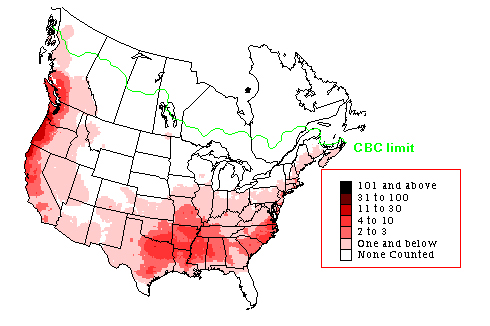
Audubon Park in Deltona, Florida
While heading down Doyle Road in Deltona in early January, I noticed a sign off of a side road that read “Audubon Park.” I couldn’t stop then, but later at home I looked online for information about the park. I couldn’t find much besides a short mention in a meeting minutes from the Deltona Parks & Recreation Advisory Board. A large part of the text involved the fact that no one on the board seemed to know where the park was located.

The boardwalk goes over a marshy area
Anyway, Arthur and I went back to the park a day or two later to see what it was like. The park consists of about 60 acres and includes four small water bodies that serve to filter waste water naturally. There is also a long boardwalk over an open marsh (now dry) and a chipped wood path through a small patch of woods. On my first visit on January 6th I was happy to see that the small water ponds had attracted a pair of Hooded Mergansers, my first in Volusia for the year. Arthur found some Eastern Bluebirds, also FOY birds for me.

Water treatment ponds

The loop trail goes into the woods
The next time I visited the park was on my mini big green day on January 19th. One great thing about Audubon Park is that it is adjacent to the new East Regional Rail Trial, which now runs through Deltona to SR415 in Osteen and will eventually extend all the way to Edgewater and Titusville (!!). However, there is currently no access from the park to the bike trail, which should really, really, be easy to facilitate. There is already a dirt road connecting the two, but it is gated. The photo above shows the dirt road heading to the bike path.

Access to the park from the trail would be through this gate
Hopefully access from the bike path to the park will eventually be opened up. Anyway, without proper access I biked to the park by going around and cycling shortly on busy Doyle Rd, something I don’t really want to do again. Of course, it was definitely worth it, because I picked up some great new BIGBY species (Green-winged Teal and both Greater and Lesser Yellowlegs). 
I felt I had discovered an under-used, unloved and virtually unknown park, but on my visit on January 31st I was surprised to find brand new signs, signs, and more signs. There are now tree ID signs all along the path, and a pair of informational signs declaring the intent of the Ledford Regional Surface Water Treatment Facility (I can’t find anything about the park using this name in a Google search, by the way). So maybe it’s not so unloved and unknown, anyway.

Many, many trees have these big, bold ID signs

LRSWTF
I’ve visited a few more times in the last couple of weeks. The small park continues to be productive, though not overwhelmingly birdy. In and around the ponds I’ve seen Cattle Egrets, Little Blue Herons, Wilson’s Snipes, a lone Spotted Sandpiper just this week, Sandhill Cranes, lots of Killdeer, and a pair of Mallards. The woods and transition habitat hold the usual suspects, including Palm and Yellow-rumped Warblers, Blue-gray Gnatcatchers, Carolina Wrens, White-eyed Vireos, Northern Mockingbirds, and others. I have also seen some interesting fungus there including Column Stinkhorn (very stinky when it was in bloom in January) and a pretty metallic mushroom.

Little Blue Heron

Hooded Merganser

Column Stinkhorn
Audubon Park is located off of Lush Lane in Deltona. Lush Lane is off Doyle Road between Saxon and Courtland. Here’s a map. The green arrow points to the parking area; you can see the water treatment ponds to the west. On the map, Ledford Road appears to run through the property, but this dirt road is blocked to public access. Ledford would be the access from the East Regional Rail Trail to the park. The Rail Trail is the line running south of the park, roughly parallel to Doyle.
Have you ever birded at Audubon Park? Do you have your own “unknown” birding spot? Let me know in the comments! Especially if it’s in Volusia County! 
Audubon Park bird species list so far (through March 1st, 2013)
Mallard (Domestic type) – Anas platyrhynchos
Green-winged Teal – Anas crecca
Hooded Merganser – Lophodytes cucullatus
Little Blue Heron – Egretta caerulea
Cattle Egret – Bubulcus ibis
Black Vulture – Coragyps atratus
Turkey Vulture – Cathartes aura
Osprey – Pandion haliaetus
Swallow-tailed Kite – Elanoides forficatus
Bald Eagle – Haliaeetus leucocephalus
Red-shouldered Hawk – Buteo lineatus
Red-tailed Hawk – Buteo jamaicensis
Sandhill Crane – Grus canadensis
Killdeer – Charadrius vociferus
Spotted Sandpiper – Actitis macularius
Greater Yellowlegs – Tringa melanoleuca
Lesser Yellowlegs – Tringa flavipes
Wilson’s Snipe – Gallinago delicata
Mourning Dove – Zenaida macroura
Red-bellied Woodpecker – Melanerpes carolinus
Pileated Woodpecker – Dryocopus pileatus
American Kestrel – Falco sparverius
Eastern Phoebe – Sayornis phoebe
White-eyed Vireo – Vireo griseus
Blue Jay – Cyanocitta cristata
American Crow – Corvus brachyrhynchos
Fish Crow – Corvus ossifragus
Tree Swallow – Tachycineta bicolor
Tufted Titmouse – Baeolophus bicolor
Carolina Wren – Thryothorus ludovicianus
Blue-gray Gnatcatcher – Polioptila caerulea
Ruby-crowned Kinglet – Regulus calendula
Eastern Bluebird – Sialia sialis
American Robin – Turdus migratorius
Gray Catbird – Dumetella carolinensis
Northern Mockingbird – Mimus polyglottos
Northern Parula – Setophaga americana
Palm Warbler – Setophaga palmarum
Yellow-rumped Warbler – Setophaga coronata
Chipping Sparrow – Spizella passerina
Savannah Sparrow – Passerculus sandwichensis
Northern Cardinal – Cardinalis cardinalis
American Goldfinch – Spinus tristis
























































